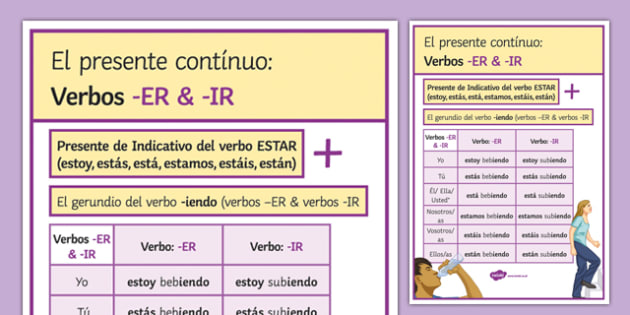
Today, we’ll learn this ending ir conjugation in multiple forms, encompassing three moods: Some less-common translations are “to head,” “to leave,” “to pass by,” “to chase after,” “to pursue,” and “to run away.” Just as in English it does not always mean going somewhere physically, but also mentally, emotionally, and when you are “going to do something.” Ir is an irregular and stem-changing verb that means “to go.” It is part of the – ir verbs in Spanish such as decir, seguir, venir and salir. Ir is one of the most used verbs in Spanish, so get ready to level up your language understanding. We’re going to learn-or vamos a aprender-about the conjugation of the verb ir in Spanish!
PAST TENSE ER IR VERBS SPANISH PDF
Want to practice more and take your Spanish to the next level? Sign up for a free class today and talk to a native Spanish speaker from Guatemala.Jby Nicole Canún Spanish Grammar 4 comments Ir Conjugation: Free Spanish Lesson, Quiz, and PDF Which ones are the easiest for you to remember? Try to describe what you see using as many regular IR and ER verbs in Spanish as possible. Think of IR and ER verbs in Spanish as a great way to say what you and others are doing around you. With these IR and ER verbs in Spanish on hand, you can express different actions and learn to conjugate each and every verb. See how many of these verbs you can remember after going through them and create a story. Now it’s your turn to create your own sentences with IR and ER verbs in Spanish! The only way to learn is by practicing. They are going to prohibit people from going out after 9:00 p.m. Van a prohibir salir después de las 9:00 p.m. I’m good at perceiving what others are feeling. Soy buena para percibir lo que otros sienten. Un accidente puede ocurrir en cualquier momento.Īn accident can occur at any time. Many people believe extraterrestrials will invade Earth. Muchos creen que extraterrestres van a invadir la tierra. If I ask for a favor, I don’t like to insist too much. Insistir: to insistĬuando pido un favor no me gusta insistir mucho.

It’s a privilege to exist in the modern age. Existir: to existĮs un privilegio existir en esta época moderna. I have to divide my time between two jobs. Tengo que dividir mi tiempo entre dos trabajos. I have to decide what to do with my life. You shouldn’t confuse students when explaining the solution to a problem. No hay que confundir a los estudiantes al explicar la solución al problema. Confundir: to confuse, confound, mess things up royally We should prepare activities or the kids will get bored. Hay que preparar actividades o los niños se van a aburrir.

You should cover your mouth when you cough. I like to surprise people on their birthday. Me gusta sorprender a las personas en su cumpleaños. You are going to break the door if you slam it. You shouldn’t make promises you can’t keep. No debes prometer lo que no puedes cumplir. Meter: to insert, put inĭebes meter todos los crayones en su caja. Los niños son buenos para esconder cosas. Los niños tienen que depender de los padres. It’s hard for him/her to comprehend math. You need the police to apprehend the thief. Se necesita a la policía para aprehender al ladrón. Las esponjas son buenas para absorber líquido. I like to keep it simple, so I chose the most common and easy IR and ER verbs in Spanish so that you can start practicing them today! Let’s get right into it. The best way to practice verbs is by memorizing their conjugation slowly and steadily. The following IR and ER verbs in Spanish will give you an idea of how useful and practical these verbs are.

PAST TENSE ER IR VERBS SPANISH HOW TO
Here’s a blog post on how to memorize conjugations in Spanish that you can use to help you speak Spanish fluently. The yo and él/ella/usted verbs in the preterit tense all have accent marks. To conjugate a verb is to change the infinitive so that it agrees with the subject, mood, and tense of a sentence.įor example, to form the verb comer, we remove the ER part of the verb and add the ending -í, -iste, -ió, -imos, and – ieron. In Spanish, all infinitives end in -ar, -er, or – ir: The category is determined by the last two letters of the infinitive, which is the base form of the verb.

In Spanish, there are three categories of verbs. How To Conjugate IR And ER Verbs in Spanish


 0 kommentar(er)
0 kommentar(er)
